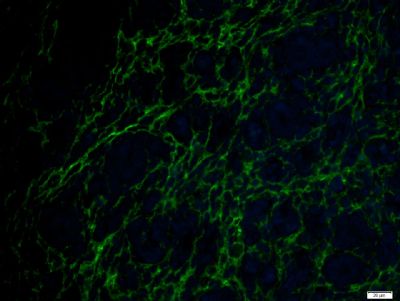ETL Polyclonal Antibody
Purified Rabbit Polyclonal Antibody (Pab)
- SPECIFICATION
- CITATIONS
- PROTOCOLS
- BACKGROUND

Application
| IHC-P, IHC-F, IF, ICC, E |
|---|---|
| Primary Accession | Q9HBW9 |
| Reactivity | Rat |
| Host | Rabbit |
| Clonality | Polyclonal |
| Calculated MW | 76 KDa |
| Physical State | Liquid |
| Immunogen | KLH conjugated synthetic peptide derived from human ADGRL4 |
| Epitope Specificity | 301-400/690 |
| Isotype | IgG |
| Purity | affinity purified by Protein A |
| Buffer | 0.01M TBS (pH7.4) with 1% BSA, 0.02% Proclin300 and 50% Glycerol. |
| SUBCELLULAR LOCATION | Cell membrane. |
| SIMILARITY | Belongs to the G-protein coupled receptor 2 family. LN-TM7 subfamily. Contains 2 EGF-like domains. Contains 1 GPS domain. |
| SUBUNIT | Forms a heterodimer, consisting of a large extracellular region (alpha subunit) non-covalently linked to a seven-transmembrane moiety (beta subunit). Forms stable dimer at the cells surface (By similarity). |
| Post-translational modifications | Proteolytically cleaved into 2 subunits, an extracellular alpha subunit and a seven-transmembrane subunit. |
| Important Note | This product as supplied is intended for research use only, not for use in human, therapeutic or diagnostic applications. |
| Background Descriptions | The epidermal growth factor (EGF)-TM7 family constitutes a group of leukocyte-restricted, class B G-protein coupled receptors (GPCRs). These include CD97, EMR1(EGF-like molecule containing mucin-like hormone receptor 1, designated F4/80 in mouse), EMR2, EMR3, FIRE, and ETL. These family members are characterized by an extended extracellular region with several N-terminal EGF domains and are predominantly expressed on cells of the immune system. Unlike other GPCRs, neither EMR2 nor EMR3 have mouse orthologs. The molecular twins CD97 and EMR2 only differ by 6 out of 236 amino acids, but this slight difference is enough to alter ligand specificity and confer nonredundant functions. EMR3 may function in myeloid-myeloid interactions during immune and inflammatory responses. ETL is a 738 amino acid protein composed of a large extracellular domain with EGF-like repeats, a seven-transmembrane domain, and a short cytoplasmic tail. ETL mRNA expression is up-regulated in the adult rat and human heart. |
| Gene ID | 64123 |
|---|---|
| Other Names | Adhesion G protein-coupled receptor L4, EGF, latrophilin and seven transmembrane domain-containing protein 1, EGF-TM7-latrophilin-related protein, ETL protein, ADGRL4 {ECO:0000303|PubMed:25713288}, ELTD1, ETL |
| Target/Specificity | Mainly expressed in smooth muscle. |
| Dilution | IHC-P=1:100-500,IHC-F=1:100-500,ICC=1:100-500,IF=1:100-500,ELISA=1:5000-10000 |
| Storage | Store at -20 ℃ for one year. Avoid repeated freeze/thaw cycles. When reconstituted in sterile pH 7.4 0.01M PBS or diluent of antibody the antibody is stable for at least two weeks at 2-4 ℃. |
| Name | ADGRL4 {ECO:0000303|PubMed:25713288} |
|---|---|
| Synonyms | ELTD1, ETL |
| Function | Endothelial orphan receptor that acts as a key regulator of angiogenesis. |
| Cellular Location | Cell membrane; Multi-pass membrane protein |
| Tissue Location | Detected in the majority of epithelial cells in tumor and normal tissues. Expressed also in human umbilical vein endothelial cells. |

Thousands of laboratories across the world have published research that depended on the performance of antibodies from Abcepta to advance their research. Check out links to articles that cite our products in major peer-reviewed journals, organized by research category.
info@abcepta.com, and receive a free "I Love Antibodies" mug.
Provided below are standard protocols that you may find useful for product applications.
If you have used an Abcepta product and would like to share how it has performed, please click on the "Submit Review" button and provide the requested information. Our staff will examine and post your review and contact you if needed.
If you have any additional inquiries please email technical services at tech@abcepta.com.













 Foundational characteristics of cancer include proliferation, angiogenesis, migration, evasion of apoptosis, and cellular immortality. Find key markers for these cellular processes and antibodies to detect them.
Foundational characteristics of cancer include proliferation, angiogenesis, migration, evasion of apoptosis, and cellular immortality. Find key markers for these cellular processes and antibodies to detect them. The SUMOplot™ Analysis Program predicts and scores sumoylation sites in your protein. SUMOylation is a post-translational modification involved in various cellular processes, such as nuclear-cytosolic transport, transcriptional regulation, apoptosis, protein stability, response to stress, and progression through the cell cycle.
The SUMOplot™ Analysis Program predicts and scores sumoylation sites in your protein. SUMOylation is a post-translational modification involved in various cellular processes, such as nuclear-cytosolic transport, transcriptional regulation, apoptosis, protein stability, response to stress, and progression through the cell cycle. The Autophagy Receptor Motif Plotter predicts and scores autophagy receptor binding sites in your protein. Identifying proteins connected to this pathway is critical to understanding the role of autophagy in physiological as well as pathological processes such as development, differentiation, neurodegenerative diseases, stress, infection, and cancer.
The Autophagy Receptor Motif Plotter predicts and scores autophagy receptor binding sites in your protein. Identifying proteins connected to this pathway is critical to understanding the role of autophagy in physiological as well as pathological processes such as development, differentiation, neurodegenerative diseases, stress, infection, and cancer.




